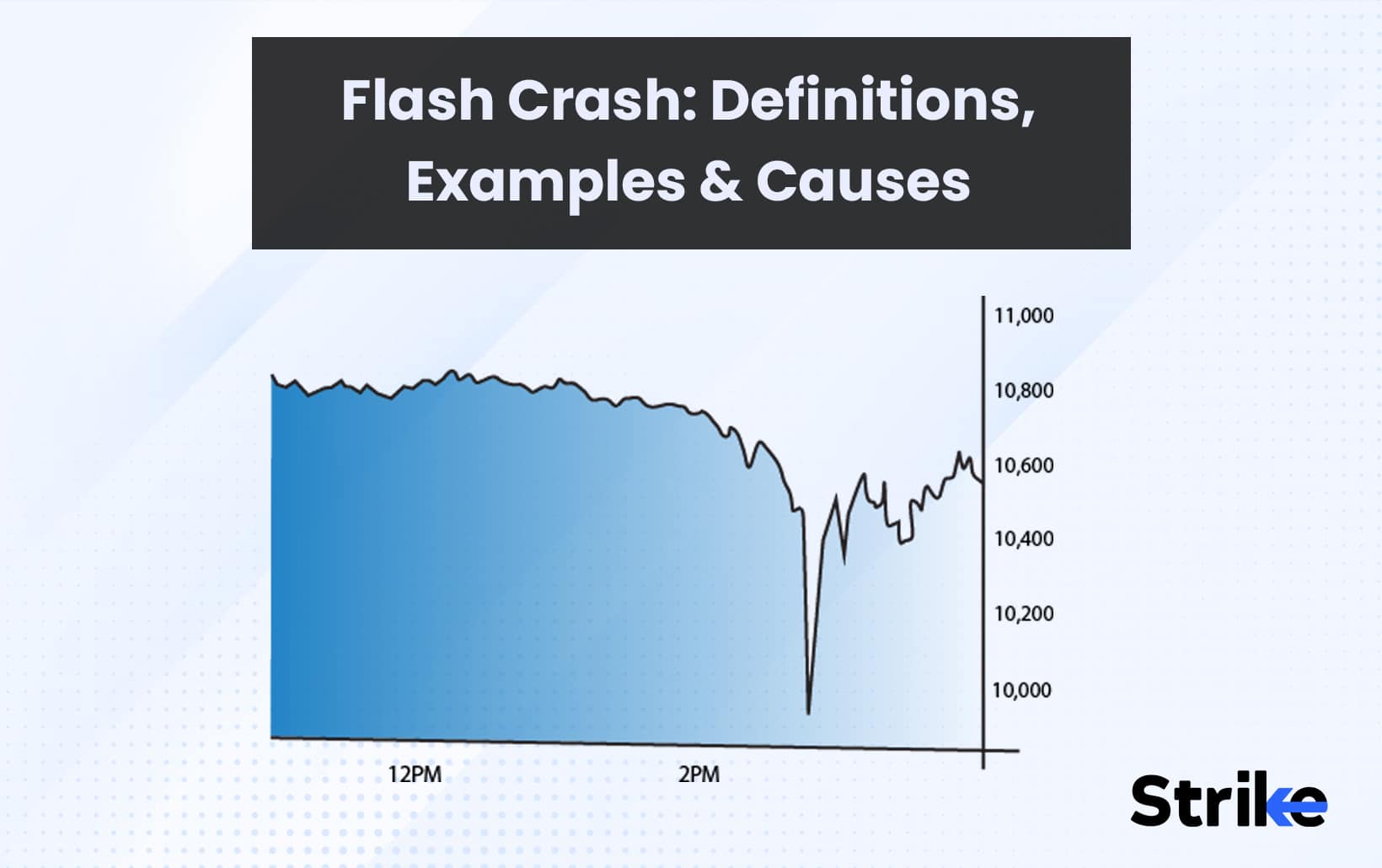
A flash crash is a sudden and significant drop in the value of an index or individual securities on a financial market. Flash crash occurrences can occur in a matter of minutes and are marked by high volatility and a rapid loss of liquidity. A flash crash happens when a significant number of orders are abruptly removed from the market, resulting in a steep drop in the share price.
Examples of flash crashes include the 2010 Dow Jones Industrial Average (DJIA) flash crash, in which the DJIA dropped nearly 1,000 points in a matter of minutes before partially recovering, and the 2013 VIX flash crash, in which the volatility index dropped from above 40 to below 10 in a matter of minutes. Factors including the dynamics of the market, algorithmic trading, and even intentional market manipulation contribute to flash crashes.
What is a flash crash?
A flash crash is an event in electronic markets wherein the withdrawal of stock orders rapidly amplifies price declines. A rapid recovery typically follows the fall because the market can absorb the abrupt reduction in demand during the decline. This phenomenon is especially prevalent in high-frequency trading, which involves the use of automated systems to respond swiftly to shifts in market conditions.
High-frequency traders take advantage of automated trading systems to buy and sell massive quantities of securities in a short period, which can lead to flash crashes. They rely on intricate algorithms and computer programs to monitor and respond to shifting market conditions.
The regulatory authorities in the United States have taken measures to prevent flash crashes, such as placing circuit breakers and prohibiting direct access to exchanges. There is still a chance that prices can plummet unexpectedly, although these precautions are in place.
The most well-known flash crash instance occurred in May 2010, when the Dow Jones Industrial Average had a steep drop of approximately one thousand points, followed by a rapid recovery. This incident was set off by a single order to sell a significant number of E-Mini S&P contracts. The trader responsible for this order was located in the suburbs of London.
Flash crashes can result in significant losses in a matter of minutes, but they can also present opportunities for astute traders to capitalize on them. Traders can take advantage of the market volatility to potentially make a profit if they have an awareness of the factors that can produce flash crashes and the potential effects those factors can have.
How often does Flash Crash happen in the Stock Market?
A flash crash does not happen very often in the stock market. A flash crash is typically caused by the rapid cancellation of orders, which amplifies price drops in a relatively brief time. Investors in the financial markets are becoming increasingly concerned about their potential impact since flash crashes can result in significant losses in a relatively short period of time. Prices immediately recover, following this, frequently within the same trading day, giving the impression that the Flash Crash never took place.
Identifying the cause for a flash crash may be challenging in most cases. Flash crashes are commonly thought to be the fault of high-frequency trading firms, which have been blamed for a significant portion of the Flash Crashes that have occurred in recent years.
High-frequency trading firms utilize computer algorithms that respond to the state of the market and immediately begin selling massive volumes of assets at an extremely rapid pace in an effort to limit their financial exposure to potential losses. There are a number of other things that create flash crashes, including anomalous market behaviour, a particular piece of market or company news, or fraudulent activity.
The most important stock market in the world, including the New York Stock Exchange (NYSE), Nasdaq, and the Chicago Mercantile Exchange (CME), have instituted a variety of safety precautions and systems in an effort to forestall the occurrence of flash crashes. Solutions include market-wide circuit breakers, which cause a halt in trading activity or a total stop in trading activity when a market’s index declines by 7% or 13% from its previous close, or a decrease of 20%, respectively, depending on the situation.
The Securities and Exchange Commission (SEC) has prohibited naked access to exchanges as well as direct links to those exchanges in order to prevent high-frequency trading companies from gaining an unfair edge in the market.
Flash crashes can result in significant losses in a relatively short period of time and hence investors in the financial markets are becoming increasingly concerned about their potential impact. Despite the fact that the actions of high-frequency traders are in direct connection with.
Does Flash Crash Affect Stocks in the Stock Market?
Yes, a Flash Crash can affect stocks in the stock market. A precipitous and unexpected drop in stock values is referred to as a “Flash Crash.” Flash crash typically takes place within an extremely brief amount of time and has the potential to result in a considerable reduction of capital in the stock market.
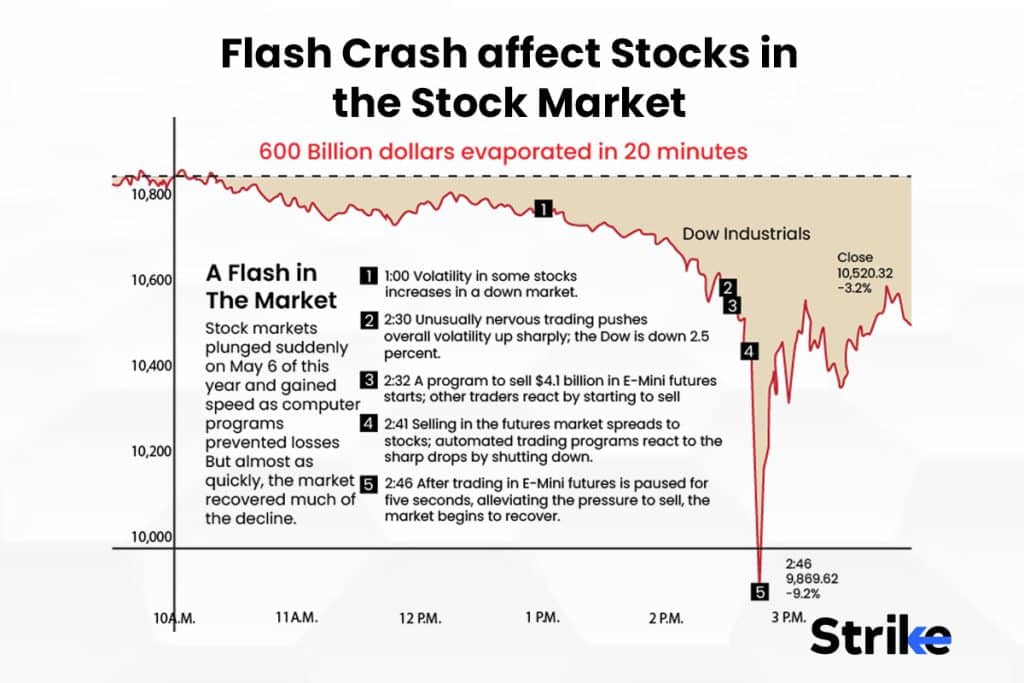
There has been a rise in the usage of high-speed computerized trading in recent years which has led to an increase in the frequency of flash crashes. Fast-speed electronic traders make deals automatically and at high speeds with the help of computers. High-speed electronic traders are distinguished by their low levels of capital as well as their flexibility in adapting their trading tactics.
These “algos” will typically switch into trading more quickly than other traders or more fiercely in the same direction as the trend. Liquidity can be quickly depleted, and a flash crash can be triggered by selling more than other people.
The stock market crash that occurred in the United States on August 24, 2015, is considered to be the most well-known example of a Flash Crash. The price of the equities product that sees the largest volume trading, the SPDR S&P 500 ETF Trust, fell to a level that was greater than 5% lower than where it had ended the previous trading day.
The E-Mini S&P 500, which is the equity-related futures product that is most actively traded, saw a price drop to its limit down price of 5% below the closing price of the previous trading day. Trading in this contract was halted as a result from 9:25 am to 9:30 am.
Another example would be the collapse of the American stock market on May 6, 2010. There were concerns about a debt crisis in Greece on this day, which led to a downward trend for the Dow that continued for the majority of the trading day. The equities market began to collapse fast, falling an additional 600 points in 5 minutes for a loss of nearly 1,000 points with the Dow already down more than 300 points for the day, by 2:47 o’clock in the afternoon. The market had recovered the majority of the 600 points that it had lost after another twenty minutes, at 3:07 p.m.
It is essential for investors to be aware of the dangers that are connected to flash crashes and to be prepared for the likelihood that a flash crash will occur. Investors should not only be aware of the potential reasons of a Flash Crash, such as low trade volumes or aggressive trading techniques, but they should also take measures to limit the risks associated with these potential causes.
What are the Examples of Flash Crashes in the Stock Market?
The stock market is significantly impacted whenever there is a flash crash. They have the potential to result in a considerable loss of capital and to have an effect on the market that is likely to be long-lasting. 6 of the major flash crashes in recent years have been given below.
1. Flash Crash of European Stock Markets on May 2, 2022
The European financial markets were hit by a catastrophic flash crash on May 2nd, 2022, which resulted in significant drops across several of the main indices. The source of the flash crash was determined to be a mistake made by a trader working at the London trading desk of Citigroup Inc. This blunder was responsible for the precipitous decline in share prices across Europe and the temporary halt in the bank’s recovery efforts.
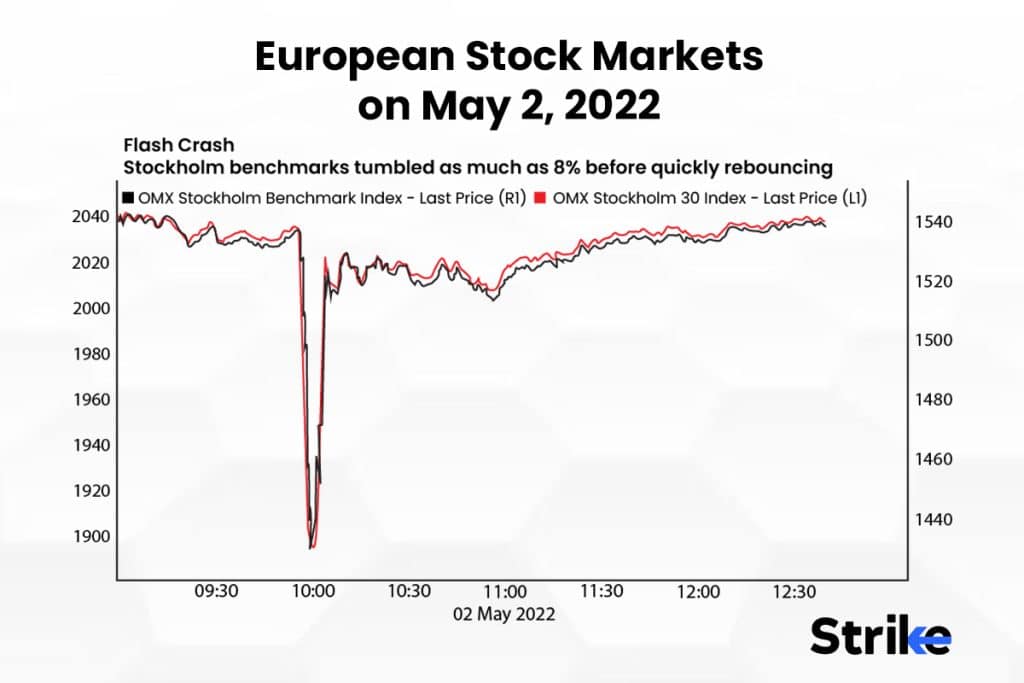
The report states that the trader submitted a massive sell order for a basket of European equities, which sparked a cascade of automatic sell orders from other traders and algorithms, which ultimately led to a significant decrease in the value of various European markets. The specifics of the error are not known at this time; however, Citigroup has begun an inquiry to establish what led to the error in the first place.
The flash collapse continued for many minutes and resulted in a precipitous drop in value across European markets.
The magnitude of the event and the range of markets that are impacted both play a role in determining how large an effect a flash collapse can have on the economy. The sudden drop in share prices that occurred on May 2, 2022, caused a flash crash, which resulted in a temporary suspension in trading and a severe loss of value for investors. Investors and traders were unable to get out of their positions as a result of the crash, which led to more drops in the market. This led to a liquidity crisis, which in turn prompted further reductions in the market. The bank’s efforts to recover were also hindered by the crash, which had a negative influence on their efforts.
2. 2019 Yen and Australian Dollar
A sudden drop in value occurred for the yen in 2019, as it did for the Australian dollar. The value of most major currencies plummeted against the yen in a matter of seconds, with the USDJPY and AUDUSD currency pairings also experiencing strong sell-offs at the same time. Ray Attrill, head of FX strategy at the National Australia Bank said that the flash crash was caused by an increase in Japanese retail FX margin trading, most likely caused by Mrs. Watanabes.
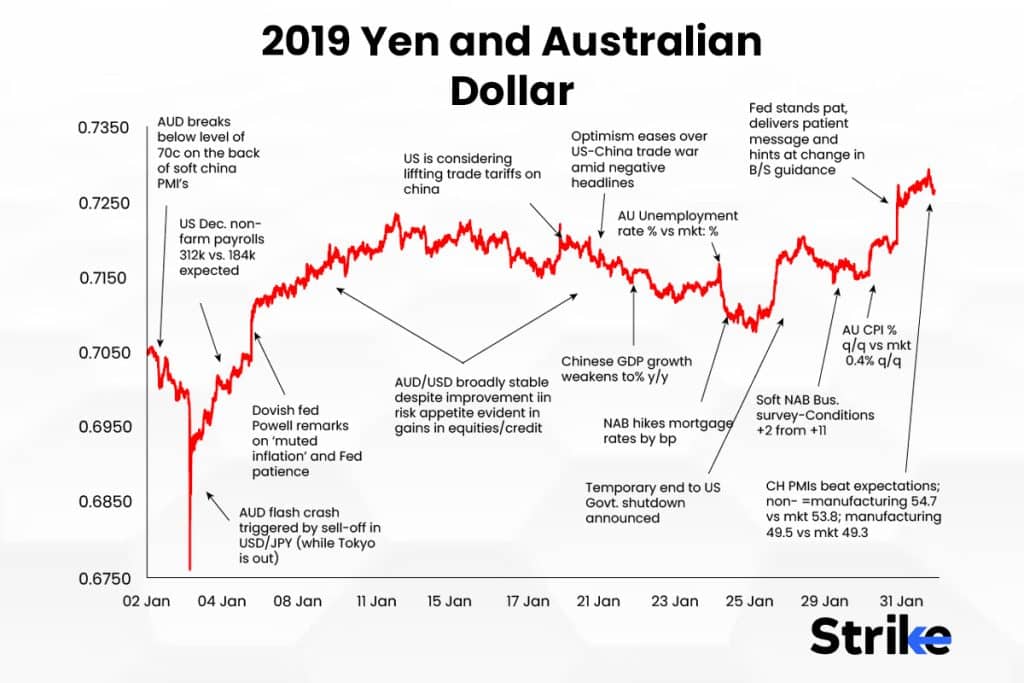
This was the moment when the flash crash occurred as a direct result of an increase in the number of retail investors from Japan participating in the foreign exchange market. Retail investors have a tendency to become more active in the market when the market is experiencing volatility, which may lead to the market experiencing higher volatility. The flash crash happened at this time when the market was going through a period of extreme volatility, which can make the repercussions of a flash crash much more severe.
The flash collapse continued for several minutes and resulted in a precipitous drop in the value of the yen as well as the value of other major currencies. It is commonly understood that a crash is a sudden and severe event that can take place within a matter of minutes, however, the precise duration of the crash will vary depending on the market or index that is being discussed.
The abrupt collapse in the value of the yen led to a decline in the value of Japanese exports, which in turn had a negative impact on the gross domestic product of the nation. The crash also had a detrimental impact on the economy of Japan, as a result of this chain reaction.
3. 2017 Ethereum Flash Crash
The price of the cryptocurrency Ethereum went through a significant flash collapse in 2017, falling as low as a penny before recovering. This was followed by a period of stability. The flash crash is widely thought to have been precipitated by a large-scale sale of the currency in response to reports of a hard fork for Bitcoin Cash. This is despite the fact that the exact cause of the flash crash is unknown.
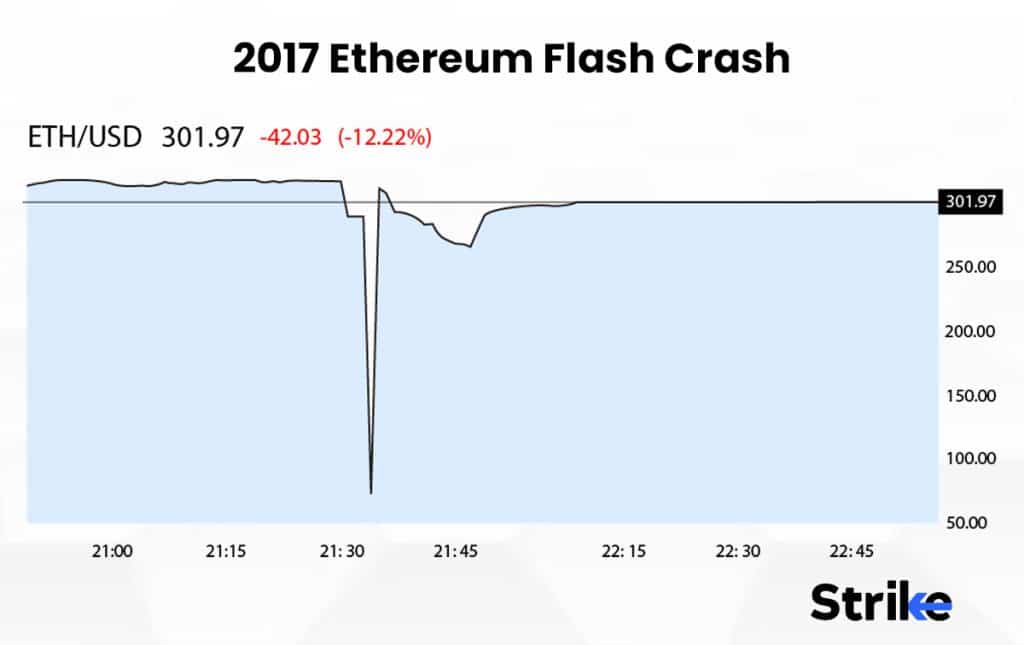
The uncertainty and confusion brought about by the hard fork for Bitcoin Cash contributed to the timing of the flash crash. The event was contentious and resulted in the creation of a new version of the Bitcoin blockchain. Investors, as a result, were motivated to liquidate their Ethereum holdings, which resulted in a precipitous drop in the price of the cryptocurrency.
A significant amount of time was lost due to the flash collapse, which resulted in a precipitous drop in the price of Ethereum.
Investors that owned Ethereum in 2017 when the cryptocurrency had a flash crash saw a considerable loss of value for their holdings, which resulted in a negative impact for investors who held Ethereum. The fall also had a detrimental effect on the cryptocurrency market as a whole because it destroyed confidence in the stability and reliability of the system. This can make it more difficult for businesses to raise funds and for investors to make decisions that are in their best interests.
4. 2010 Flash Crash
The Flash Crash of 2010 was a significant event that occurred in the financial markets, and it resulted in a decline of about 1,000 points in the Dow Jones Industrial Average in just a few minutes. The quick decline in market value that occurred during this flash collapse is thought to have been triggered by high-frequency trading algorithms.
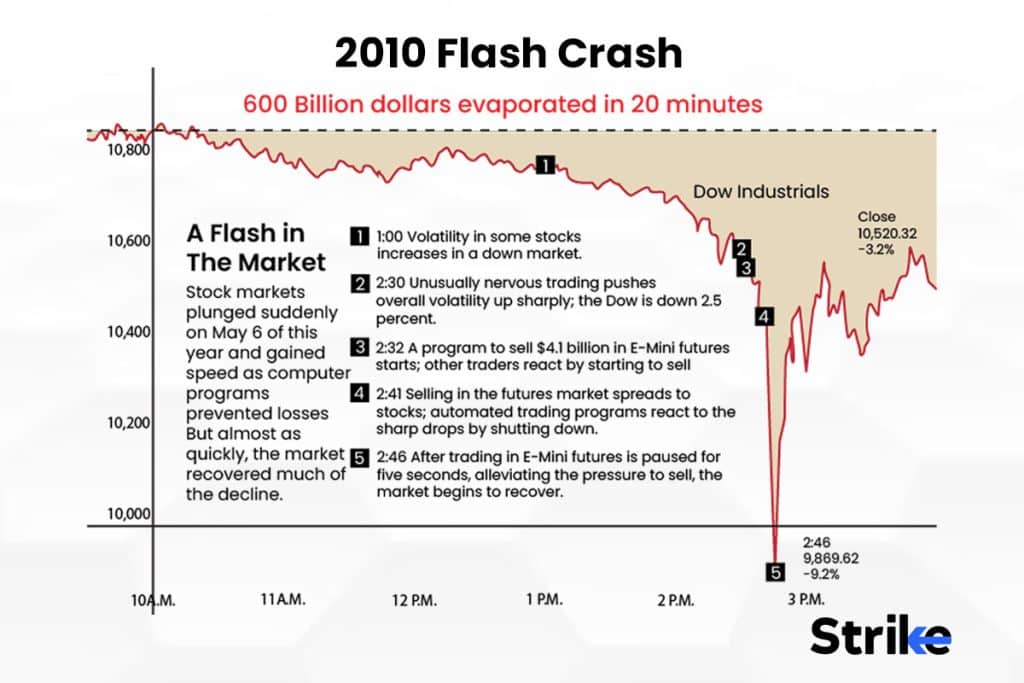
The high-frequency trading algorithms that were active in the market contributed to the flash crash that took place at this particular moment in time. These algorithms, which are meant to carry out trades at the speed of light or faster, have the potential to worsen the volatility of the market and contribute to flash crashes.
The flash crash continued for a few minutes and resulted in a precipitous drop in the value of the Dow Jones Industrial Average.
Investors suffered a large loss of value as a result of the flash collapse that occurred in 2010, which also resulted in a brief halt in trade. The crash had a detrimental effect on the economy as a whole because it damaged confidence in the safety and reliability of the financial markets. This can make it more difficult for businesses to raise capital and for investors to make decisions that are in their best interests.
5. British Pound Flash Crash
The Flash Crash of the British Pound in October 2016 caused the value of the currency to drop dramatically in comparison to that of the US dollar. The sudden market decline was brought on by a confluence of a number of factors, the most significant of which was a lack of liquidity in the markets brought on by the Bank of England’s decision to maintain low-interest rates and an unexpected decision to reduce the bank’s holdings of corporate bonds.
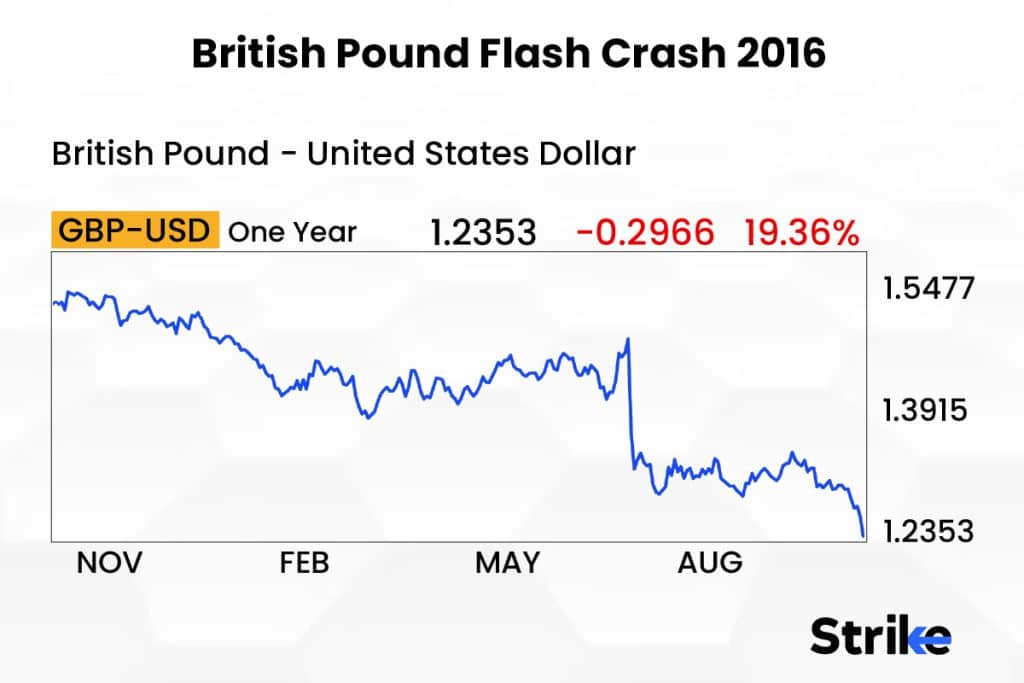
The market had previously been going through a period of severe volatility, which can make the repercussions of a flash crash even worse.
The flash crash continued for a few minutes and resulted in a precipitous drop in the value of the British pound in relation to the value of the US dollar.
6. USDJPY and AUDUSD Flash Crash
The growth in Japanese retail FX margin trading that most likely was carried out by “Mrs Watanabes,” a phenomenon of Japanese housewives who trade foreign exchange online, was the root cause of the USDJPY and AUDUSD Flash Crash that took place in March 2019. This crash occurred in both currencies. It is common knowledge that retail investors are more active during periods of heightened market volatility; as a result, it is assumed that the increased volatility in the FX market was caused by these retail investors.
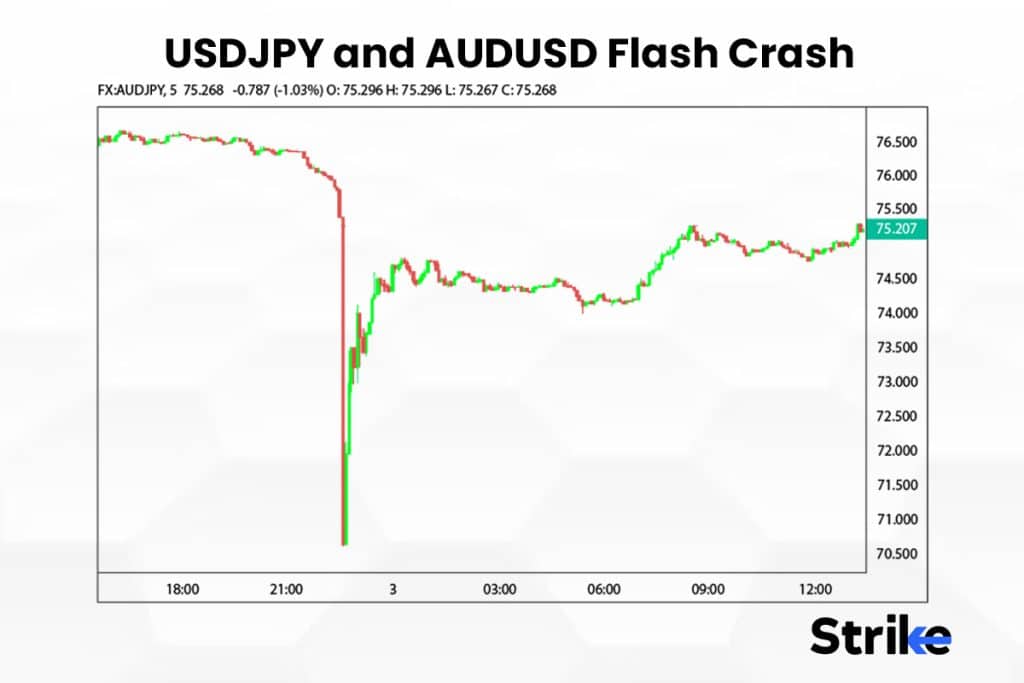
This was the moment when the flash crash occurred as a direct result of an increase in the number of retail investors from Japan participating in the foreign exchange market. These retail investors have a tendency to become more active in the market when the market is experiencing volatility, which might lead to the market experiencing higher volatility.
The flash crash lasted for several minutes, causing a rapid decrease in the value of most major currencies versus the yen and triggering a quick sell-off of the USDJPY and AUDUSD pairs. The flash collapse was caused by a sudden increase in volatility in the market.
Flash crashes occur when they are least expected. It is commonly understood that a crash is a sudden and severe event that can take place within a matter of minutes, however, the precise duration of the crash will vary depending on the market or index that is being discussed.
What causes a Flash Crash?
The cause of a flash crash is not always easy to identify, but it is typically linked to sudden and extreme market volatility. Flash crashes generally involve a large volume of trading in a short period of time, leading to sharp declines in the prices of stocks, bonds, or commodities. Factors that can contribute to a flash crash include the use of algorithms to execute trades, high-frequency trading, and the release of negative news that causes investors to exit the market.
Trading algorithms are computer programs that are designed to execute transactions according to a predetermined set of criteria. “algorithmic trading” has grown increasingly popular in recent years. This is due to the fact that computers are able to take massive amounts of data and perform big-volume trades within a second, which is beyond the ability of humans. Trading based on algorithms can result in greater market volatility as well as a reduction in market liquidity, all of which are factors that can contribute to a flash crash.
Another element that plays a role in the occurrence of a flash collapse is high-frequency trading. The employment of algorithms is essential to the success of this form of trading, which enables the execution of a huge number of deals at a breakneck pace. High-frequency traders may also participate in unlawful actions such as “spoofing,” which is when traders make huge orders but then withdraw them right before they are filled. This is an example of a high-frequency trading scam. Prices are driven down when such a massive order is placed, and the traders are then able to buy at the decreased price.
Last but not least, the dissemination of unfavourable news might trigger a sudden market decline. Investors will hurry to sell their positions when they become concerned about a possible market collapse as a result of negative news, which will lead to a quick decline in prices. Prices will swiftly rebound if it turns out that the news is not as awful as was initially thought.
What should the traders do during a Stock Market Flash Crash?
Traders should take steps to protect their investment capital during a stock market flash crash. The first step is to remain calm, as it is important to make decisions based on facts rather than emotion. They should consider the following 5 steps once traders have assessed the situation:
- Reduce Your Exposure – Traders should reduce their exposure to the market by closing out any existing holdings and reducing the number of new trades they make. Taking this step will help to lower the probability of suffering additional losses.
- Traders should use stop-loss orders to restrict the amount of money they lose. Stop-loss orders should be placed at specified levels. This is an excellent strategy for limiting losses and protecting capital during a downturn in the market.
- Keep a Careful Eye on the Market – Traders should keep a close eye on the market in order to evaluate the current situation and decide what the best next step is.
- Consider the Effects of Long-Term Opportunities – Speculators should examine the situation to determine whether there are any long-term chances, as flash collapses frequently provide an opportunity to purchase stocks at a discounted price.
- Rebalance Your Portfolios After a Flash Drop – It is a good time to rebalance your portfolios and make sure they are adequately diversified after a sudden crash in the market.
Traders can preserve their investment capital and reduce the amount of damage that is caused by a flash crash in the stock market by following the guidelines that have been outlined above. It is essential to keep in mind that flash collapses can occur for no discernible reason, and as a result, traders should always be ready for the worst-case scenario.
Can Flash Crash be prevented?
Yes, “Flash crashes” can be avoided, but it is difficult to totally do away with the possibility that they will take place. Circuit breakers are one type of precaution that regulatory authorities have developed to prevent flash crashes.
These triggers cause trade to be halted if prices decrease too quickly in a short period of time, which is one of the criteria for activating the circuit breakers. Direct access to exchanges are also restricted so that high-frequency traders cannot gain an unfair edge in the market.
Is Flash Crash something to worry about?
Yes, despite the fact that flash crashes can be avoided, they should nonetheless be considered a source of concern. There is the potential for sudden and significant losses in the market, which can obliterate billions of dollars worth of value in a matter of minutes if a flash collapse occurs. The harm caused by a flash crash can still be severe despite the fact that flash crashes often only last a brief period of time and prices swiftly recover. Investors stand to lose a significant amount of money if prices continue to fall at such a rapid rate, and it will be challenging to make up for those losses.
Crashing prices in a flash can sometimes have a lasting impact on the market. For instance, it is possible that investors will become less inclined to invest and begin to worry that similar occurrences are possible in the future which will lead to a fall in liquidity. This could result in a fall in the value of securities as well as a reduction in the activity level of the market as a whole.
Does Flash Crash Affect the Economy?
Yes, the impact that flash crashes have on the economy is directly proportional to the severity of the crash and the length of time that it continues. It can bring about a reduction in liquidity, a reduction in the value of securities, and a reduction in the general activity of the market if a flash crash is significant and continues for an extended period of time. A lull in market activity may well pave the way for a recession, which, in turn, may have unfavorable consequences for the economy.
What is the difference between a Flash Crash and Stock Market Crash?
The rate at which the events unfold is the primary factor that differentiates a flash crash from a regular stock market disaster. A crash in the stock market is normally an extended and drawn-out process, but a flash crash takes place extremely quickly.
A stock market crash is typically brought on by a decline in market conditions, whereas a flash crash may be brought on by factors, such as algorithmic trading, high-frequency trading, or the dissemination of unfavorable news. A crash in the stock market can also have more long-lasting impacts, but a flash crash is often short-lived and prices swiftly recover after the drop.




![85 Common Stock Market Terminologies for Dummies [Updated List for 2025] 18 85 Common Stock Market Terminologies for Dummies [Updated List for 2025]](https://www.strike.money/wp-content/uploads/2025/04/Popular-Stock-Market-Terms-for-Beginners-Banner.png)










No Comments Yet.